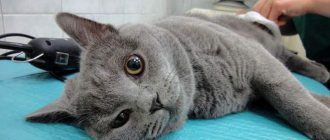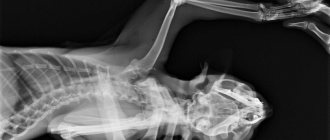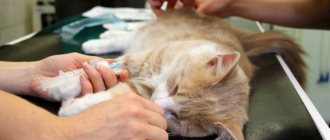Cat castration is one of the most popular services provided by veterinary clinics. It is an operation whose purpose is to block the functioning of the sex glands.
After the procedure, cats not only cease to experience sexual desire, but become less aggressive, calmer, tame, voracious, and lethargic. Positive aspects include the fact that cats stop marking territory, yelling, and the risk of the occurrence and development of diseases such as prostate cancer and prostatitis is significantly reduced.
The price for castrating a cat today is kept at a fairly low level, so many pet owners prefer to contact specialists at a veterinary clinic with a request to castrate the animal.
But a competent veterinarian will not always undertake the operation: for example, if the cat is exhausted or too small (up to seven months), if he has been diagnosed with diseases of the lungs or cardiovascular system, the specialist will be forced to refuse castration. The procedure will also have to be postponed if the animal has been vaccinated over the past two weeks or is planning to do so (as planned) in the near future.
What is castration?
Castration is an operation in which there is a complete loss of the ability to reproduce as a result of removal of the reproductive system.
Purposes of castration of cats and female cats:
- control over the reproduction and reproduction of domestic and street animals;
- behavior correction (during the hunting season in cats);
- maintaining hygiene (when pets begin to leave marks throughout the home).
In some cases, surgery is performed according to indications for the treatment of diseases:
- in cats: orchitis, prostatitis, neoplasms of the testes, perineal hernia;
- in cats - pyometra, cystic ovarian formations, uterine bleeding, neoplasia, false pregnancy, radical cesarean section.
Castration of a cat before puberty (before the first heat) is the only measure to prevent neoplastic processes in the mammary gland in the future. The operation performed after the 3rd heat no longer guarantees that the pet will not have malignant neoplasms. It has been proven that safe castration of a male cat is possible from the age of four months.
Methods used:
- surgical (the animal is given anesthesia and surgery is performed);
- medicinal (during sexual heat the pet is given hormonal drugs).
Why do you need to castrate cats?
When choosing between who to take into the house - a “boy” or a “girl”, many prefer male kittens. But by six months the cute kitten begins to show sexual activity. The result affects the furniture, carpets, and shoes of the owners. A cat living at home instinctively leaves odorous marks that cannot be eliminated.
Often, a cat’s natural instincts lead to tragedy. An animal can jump out of a window or from a balcony, or slip out of a slightly open door. If a cat has never been outside, he will not be able to withstand a fight with tailed street fighters. And the cat is unlikely to find his way home. Another "lost" one. Even if the cat was found and returned home, it is not a fact that he did not manage to become infected with the infection from street animals.
The other “side of the coin”: castration will help reduce the population of animals born on the streets. If a cat is free-range, he will definitely find a “girlfriend”. Weak and non-viable kittens are doomed to death or even more sickly offspring.
Castration of a cat changes not only its sexual habits, but also its character. The animal stops marking its territory and calmly treats the females living in the house. Owners note the gentler and calmer disposition of a neutered cat - he does not show aggression towards people or “rivals”.
How is a cat castrated?
Before the operation, the pet undergoes a full clinical examination, which includes determining general health, palpation of the abdominal wall, temperature measurement, and auscultation. The planned procedure is performed only on healthy animals. In other cases, additional research may be needed to assess the possible risks.
It is important to remember that each animal may have individual intolerance to the components of the substances used for anesthesia.
Methods for castrating a cat:
- open - the surgeon dissects all layers in the scrotum area and through a small incision removes both testicles one by one. The spermatic cord and vessel are ligated or tied to a biological knot. The second option is considered the most reliable and cheapest way. When performing a biological knot, no suture material or technical devices are used. Such a node does not reject and does not become inflamed;
- closed - rarely used in cats, at the discretion of the surgeon. The technique is similar to the open one, only the dissection does not affect the common vaginal tunic;
- amputation of the scrotum and testicular sac - indications for such an operation may be purulent inflammation or a neoplastic process in the testicular area.
Cryptorchidism is a phenomenon when one or both testes do not descend into the scrotal cavity. How is castration of a cryptorchid cat carried out? In case of inguinal localization, the testis is removed through an incision in the skin. If in the abdominal cavity, then abdominal surgery is performed, as a result of which the incorrectly located organ is removed after detection.
Possible complications after castration of a cat
- bleeding - occurs when a biological knot is untied or a ligature comes off;
- prolapse - protrusion through the groin area of the stump of the testicular cord, abdominal organs;
- local inflammation - ligature fistulas, hematomas (of scrotal tissue).
Operation description
Before surgery, you must visit a veterinarian to examine the animal. The doctor checks the pet’s condition, the presence or absence of diseases, mechanical damage, and pathologies that can make the operation dangerous. If everything is in order, then the day and time of the operation is set.
The animal should not be fed 12-14 hours before surgery . Typically, surgery is scheduled for the morning (8-9 hours), so you can feed the cat until 18 hours the day before.
In the morning you bring your pet to the clinic, the doctor begins the operation immediately:
- The cat is given an injection for anesthesia, usually propofol or xylazine is used. In the first case, the narcotic state is achieved immediately, in the second it develops within 5-30 minutes.
- When anesthesia is achieved, the animal is fixed on its back, its paws are also secured so that they do not interfere. Everything takes a few minutes.
- The surgical field is first shaved and then treated with antiseptics. This stage also lasts no more than 5 minutes.
- The surgeon makes an incision on one side of the scrotum and removes the testis along with the covering membrane and the testicular appendage. The appendage must be removed so that there is good access to the tail of the appendage, a ligature is applied to it to prevent bleeding, after which the testis is cut off along with the appendage. This stage, although simple, requires great care and can take 5-7 minutes.
- The previous procedure is repeated on the second testis, which also takes 5-7 minutes.
- After this, the wound is sutured, usually not by a doctor, but by an assistant. The procedure, although simple, can take 5-7 minutes, as 4-6 stitches are required. This step is often skipped because in most cases the surgical wound does not require stitches.
Castration of a cat
Unlike cats, castration of cats is a full-fledged abdominal surgery. That is, during the manipulation, the surgeon makes access through the abdominal wall and removes the female’s reproductive organs.
According to the type of surgical access, cat castration is carried out in two types:
- along the white line (retro-umbilical region);
- in the area of the right iliac region, along the lateral abdominal wall. This method is used less frequently, since if complications arise, it is necessary to make an incision along the entire side or a new access along the white line.
By technique:
- oophorectomy - as a result of the operation, only the ovaries are removed, the horns and body of the uterus remain in the abdominal cavity. This type is rarely used, since subsequently an inflammatory process may begin in the uterine cavity;
- Ovariohysterectomy - during surgery, both the ovaries and the uterus are removed from the abdominal cavity.
Possible postoperative complications
- Ovarioreminant syndrome - sexual behavior persists after castration. The reason is incomplete removal of ovarian tissue. With this problem, the only way to solve it is a repeat operation.
- Cultitis is an inflammation of the remaining part of the uterus.
- Bleeding.
At what age is it better to castrate a cat?
Veterinarians recommend castration of kittens at the age of 6-9 months. By this age, the animal has already formed, and the removal of the genital organs - the testes - will not affect the hormonal background of the body.
If the operation is performed on an adult animal, the animal’s sexual habits are often preserved - it can still mark its territory and fight with “rivals.” Sometimes castration is prescribed for adult animals and even elderly animals with certain diseases of the genitourinary system.
How long does it take to castrate a cat?
In terms of the duration of the operation, the usual castration of a cat (without complications) lasts 15–20 minutes. Afterwards, the pet remains under anesthesia for several more hours. Awakening occurs after 1–2 hours, depending on the drugs used.
Castration of a cat takes longer, as it is a full-fledged abdominal operation. On average, an ovariohysterectomy takes 40–60 minutes.
The importance of finding a suitable veterinary clinic
Today, any more or less large veterinary clinic includes castration of cats in its list of services. But not all clinics are ready to offer their clients the optimal balance between the quality of services and their cost. Among this variety, how can you choose a clinic whose services will suit you both in terms of quality and price? Use the services of the Petstory.ru service.
Petstory.ru is a unique service that will allow you, without leaving your home, to compare the cost of castration of a cat in different clinics and choose the best offer for your city or region.
It's no secret that in different veterinary clinics prices for castration of cats can be different, sometimes this difference is quite noticeable, and is not always justified. Our service presents only trusted organizations that provide high quality services, so whatever choice you make, you can be sure that it will be the right one.
In addition to information about prices for castration of a cat in a clinic, on the Petstory.ru portal you will find a lot of useful and interesting information - about the types of services that are provided in a particular veterinary clinic, about the rules of care and maintenance of pets (including in the postoperative period ), about the characteristics of various breeds, about the symptoms of diseases, about how to behave in certain situations with your pets.
Add the resource Petstory.ru to your browser bookmarks, you will always be able to provide your pet with quality care and find a good and inexpensive veterinarian for him.
News on Notepad-Volgograd
Postoperative period
When can you feed a cat after castration?
You can offer food after castration a few hours later. Start with a small portion of wet food. Gradually the amount of food begins to increase.
General animal care
Recommendations for cats:
- if your pet licks the area under its tail, you must wear a protective collar;
- the filler is removed from the tray for 3–4 days.
For cats:
- Do not remove the postoperative blanket for the entire rehabilitation period. It must be dry and clean;
- Treat the seams once a day with a solution of hydrogen peroxide, then apply Levomekol in a thin layer.
- if necessary, the doctor prescribes antibacterial agents;
- the sutures are removed after 10–14 days (if absorbable suture material is used, there is no need to remove the sutures; the outer part of the suture disappears approximately at 10–14 days).
Castration of cats and female cats is a necessary operation that can prolong the life of a pet. Complications after the procedure are rare. Early castration of non-breeding cats is the best prevention of cancer processes.
Advantages of performing surgery at home
Castration of a cat at home is carried out only when the following rules are met:
- the cat is vaccinated;
- deworming should be carried out no later than 3 months ago (otherwise it will be repeated);
- the last feeding is carried out 12 hours before, the last drink of water is 2 hours before the procedure;
- the animal must have a good appetite and strong immunity.
The best room for castration is the bathroom. Everything unnecessary is removed from it, walls and household items are washed and disinfected. However, other rooms where cleanliness and sterility can be ensured are also suitable. It is advisable to ventilate the room well before the operation.
Find out more about castrating a cat at home.
What manipulations are performed when installing an implant?
The main steps when using the classical technique:
- Introduction of an anesthetic drug.
- Cutting the gums and peeling off the mucoperiosteal flap.
- Formation of the bone bed, with its gradual expansion until the desired size is achieved.
- Periodic irrigation of tissues to prevent overheating of the bone.
- Screwing a metal implant into the hole and installing a plug.
- Placement of mucoperiosteal flaps and suturing.
Reaction to anesthesia
How do cats cope with castration and anesthesia during it? If the animal is diagnosed with heart failure, this may negatively affect the condition after administration of the drug. Also at risk are certain breeds of cats - British, Scottish fold and others.
Signs of complications include severe shortness of breath and heart failure. To prevent this condition, the animal’s heart should be examined before surgery using ultrasound and ECG. If the risk of complications is high, it makes sense to refuse the operation or perform it under local anesthesia.











